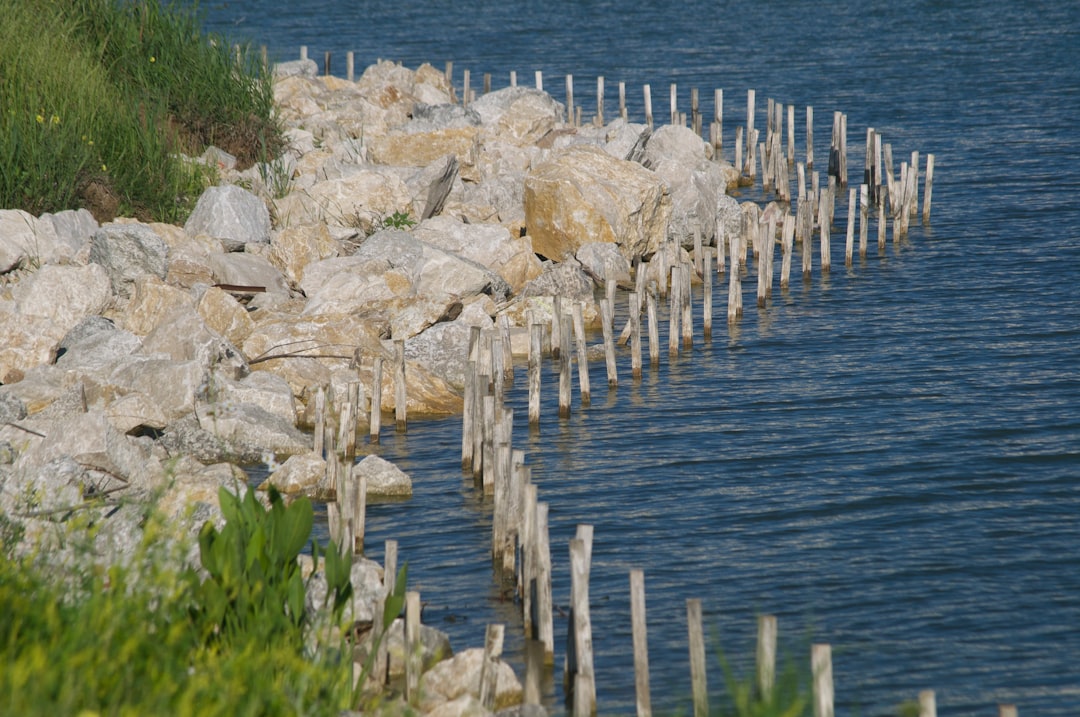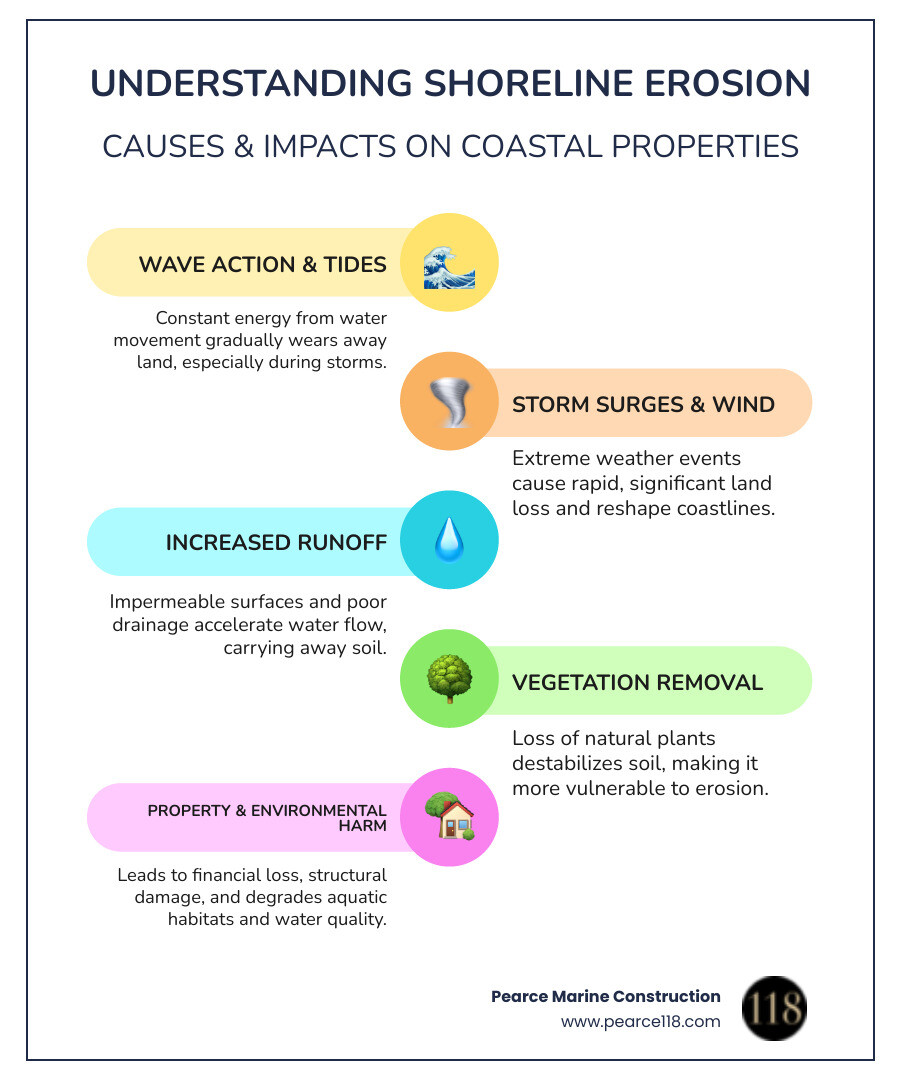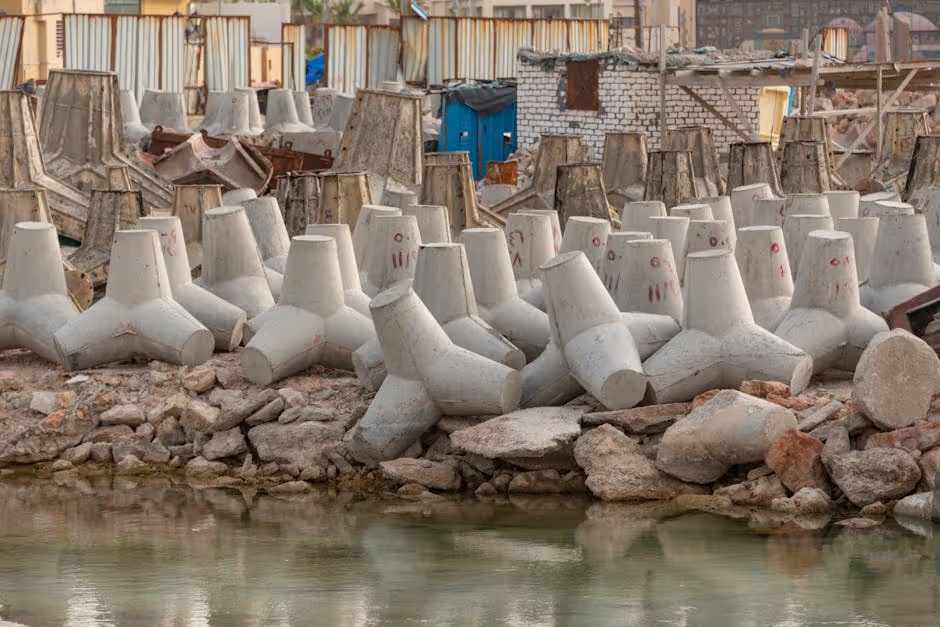The Shore Thing: Effective Strategies for Shoreline Protection

Protecting Your Waterfront: Understanding Shoreline Erosion Protection
Shoreline erosion protection is the vital process of safeguarding waterfront properties from the gradual wearing away of land.
Here's what you need to know at a glance:
- What it is: The natural or accelerated loss of soil and land along a body of water.
- Why it's needed: Prevents property damage, structural instability, financial loss (erosion can result in over $9,000 worth of losses for every 1 foot of shoreline recession on a 100-foot property), and environmental harm.
- How it works: Involves strategies to stabilize the shoreline, often using "hard" structural methods (like bulkheads) or "soft" nature-based solutions (like native plants).
- Who it affects: Waterfront homeowners and commercial property owners, especially in dynamic coastal areas like Long Island.
For Long Island waterfront property owners, the beauty of coastal living comes with the challenge of erosion. The constant action of waves, wind, and human activity can eat away at your land, putting your property, investment, and the local environment at risk.
Protecting your shoreline maintains property value and keeps our waterways healthy. This guide covers the causes and effects of shoreline erosion and explores the best ways to protect your waterfront property for the long term.
Pearce Marine Construction, a woman-owned company with generational expertise, understands these challenges. Serving residential, commercial, and public clients across Nassau and Suffolk Counties, we specialize in durable, custom marine construction solutions designed to protect and improve your waterfront.

Shoreline erosion protection terms to remember:
Understanding Shoreline Erosion: Causes and Consequences
Shoreline erosion is the natural process of soil and land wearing away along coastlines. While this has happened for millennia, human activities can dramatically accelerate it, making shoreline erosion protection necessary.
The financial impact is significant. Losing just 1 foot of shoreline on a 100-foot property can cost over $9,000 in lost land value, not including potential damage to foundations or septic systems.
The environmental damage is also severe. Eroded soil is the largest water pollutant by volume in the U.S. It clouds water, blocking sunlight needed by underwater plants, and can carry pollutants that harm fish and destroy the aquatic habitats that make Long Island's waters special.
Long Island's unique coastline, with its mix of protected bays and open ocean exposure, creates a perfect storm for erosion. Understanding the causes is the first step in protecting your waterfront investment.
Natural Causes of Shoreline Wear and Tear
Natural forces have always shaped our coastlines.
Wave action is a primary driver of erosion. A wave twice as tall carries four times the energy, and even gentle lapping causes gradual wear.
Storms like nor'easters accelerate erosion, bringing powerful waves, storm surge, and torrential rain that can reshape a waterfront in hours.
Tides weaken soil structure through their constant ebb and flow, making soil particles easier to wash away.
Ice buildup is a major force on Long Island. Expanding winter ice can push against shorelines with incredible force, while freeze-thaw cycles lift and move soil particles.
Wind contributes by blowing away dry soil and creating waves. Natural sediment transport and longshore drift constantly move materials along the coast. Bluff erosion is a dual threat, with waves attacking the base while runoff erodes the top.
How Human Activities Can Accelerate Erosion
Many property improvements can inadvertently worsen erosion.
Vegetation removal is a common mistake. Native plants have deep root systems that act as a natural retaining wall, holding soil and absorbing wave energy. Replacing them with a manicured lawn removes this vital protection.
Lawns to the water's edge offer little erosion control and contribute to fertilizer runoff, harming water quality.
Improper construction near the shoreline can destabilize the area, especially when natural protective features like logs and rocks are removed.
Increased runoff from impermeable surfaces like patios and driveways is a major problem. Instead of soaking into the ground, rainwater rushes to the shoreline. Poorly designed drainage can concentrate this flow, carving gullies and accelerating erosion.
Boat wakes often carry more energy than natural waves of the same size, constantly battering the shoreline.
For more specific information about erosion challenges in our area, check out our detailed guide on Long Island Beach Erosion.
A Tale of Two Shores: Comparing Hard and Soft Protection Methods
When it comes to shoreline erosion protection, there are two main approaches: "hard" structural solutions and "soft" nature-based methods. Hard armor builds a wall against nature, while soft armor works with it. Many of the best modern solutions are hybrid systems that combine both.
The right choice depends on factors like wave energy and site conditions. High-energy environments often require hard structures, while low-energy areas can thrive with softer solutions. Your site-specific needs and long-term goals are critical to the decision.
| Feature | Hard Armor | Soft Armor |
|---|---|---|
| Effectiveness | Immediate, robust protection in high-energy areas | Excellent in low-to-moderate energy, highly effective in hybrids; promotes long-term resilience |
| Initial Cost | Can be high due to materials and specialized labor | Often lower, especially with volunteer labor; some engineered soft solutions can be moderate to high |
| Maintenance | Can be low for well-built structures, but repairs are costly | Moderate to high initially (watering, replanting); lower once established, self-repairing |
| Environmental Impact | High; habitat alteration, increased scour, reflection, flanking, less natural scenic beauty | Low to beneficial; habitat creation, water quality improvement, sediment trapping, natural aesthetics |
| Permitting Complexity | High; often requires extensive review and multiple agencies | Moderate; typically favored by regulatory agencies, but still requires approvals |
"Hard" Armor: Structural Solutions for Shoreline Erosion Protection
Hard armoring involves engineered structures like seawalls, bulkheads, revetments, and retaining walls. These solutions offer immediate and robust protection, making them ideal for high-energy coastlines where softer methods would fail. They are also valuable for protecting infrastructure in tight spaces where a vertical barrier is needed.
However, hard structures can have drawbacks. They protect the land behind them but can cause wave scouring, where deflected wave energy erodes the base of the structure and the adjacent beach. Flanking occurs when wave energy is redirected to a neighbor's property, increasing erosion there. These structures also replace natural habitats with static barriers.
Despite these challenges, when a hard structure is necessary, it must be built correctly with professional design, quality materials, and expert installation. A well-built bulkhead or seawall is a long-term investment that can protect a property for generations.
"Soft" Armor: Nature-Based Solutions for Shoreline Erosion Protection
Soft armoring works with natural processes to create living shorelines. These solutions use plants and natural materials on gentle slopes to absorb wave energy while creating functional ecosystems. Environmental agencies often favor these approaches for their ecological benefits.
Strategic vegetation is the core of most soft armor systems. Deep-rooted native plants bind soil and dissipate wave energy. A simple no-mow buffer zone can make a significant difference.
Riprap, or sloped layers of large stones, absorbs wave energy instead of reflecting it. When combined with plants (vegetated riprap), it offers both stability and ecological benefits.
Beach nourishment adds sand to restore a beach's width, improving its natural protective qualities and recreational value. Coir logs, made from coconut fiber, can trap sediment and provide a base for new plants to grow in calmer areas. They are biodegradable, lasting 6-10 years while vegetation takes over.
Nature-based solutions create habitat for wildlife, improve water quality, and can become self-repairing systems that strengthen over time. Many property owners also prefer the natural aesthetic of a living shoreline.
Your Guide to Effective Shoreline Erosion Protection
A successful shoreline erosion protection project requires careful planning to create a solution that protects your property for decades. The best projects begin with realistic budgeting and clear long-term goals, whether it's maximizing protection, maintaining water access, or creating wildlife habitat.
At Pearce Marine Construction, we know that successful projects start with a thorough understanding of your unique shoreline. Our job is to assess your property's specific conditions before recommending the right solution.
Key Planning Steps Before You Begin
Before beginning any project, a thorough site assessment is essential. Every waterfront property is unique, shaped by soil, wave patterns, and other natural forces.
Soil analysis is foundational. Understanding your soil's composition (sand, clay, loam) is key to determining the right approach, as each has different stability properties.
Slope stability analysis tells us how much stress your shoreline can handle. High bluffs (over 20-30 feet) require specialized approaches.
Understanding water levels and wave energy at your location is crucial. We analyze both typical and storm conditions to determine the most effective protection method.
Sediment transport patterns reveal how materials naturally move along your shoreline, helping us avoid creating erosion problems elsewhere.
Your property goals are just as important as the technical details. Your desired views, water access needs, and wildlife habitat goals all shape the final design.
We always recommend professional evaluation. An experienced team can spot potential issues before they become costly problems, preventing wasted time and money on ineffective solutions.
Popular Structural and Hybrid Solutions
Our expertise spans both time-tested structural methods and innovative hybrid approaches. The most successful projects often combine the reliability of structures with the adaptability of natural systems.
Vinyl seawalls are a popular modern option, lasting up to 40 years and resisting marine borers common in our waters. They offer a durable, low-maintenance investment.
Concrete bulkheads are the gold standard for strength. We use 4,000-5,000 PSI marine-grade concrete for maximum durability and a clean, finished look.
Timber bulkheads provide a classic aesthetic. We use only marine-grade, pressure-treated lumber or select tropical hardwoods for ultimate resistance to marine borers.
Riprap revetments absorb wave energy by using layers of durable stone over filter cloth to prevent soil washout.
Gabions—wire cages filled with stone—offer a flexible and permeable alternative to rigid walls. They can be stacked and vegetated to blend into the landscape.
Integrated bank treatments are the future of shoreline protection. These hybrid solutions might combine a bulkhead with vegetated riprap or use other bioengineering techniques to create a system that grows stronger over time.
Simple Ways Property Owners Can Help
You can make a real difference with simple choices.
Managing surface runoff is one of the most powerful tools. Direct downspouts away from the shoreline and onto vegetated areas where water can be absorbed, preventing it from creating erosive channels.
Limit hard surfaces like large patios. Every square foot of impermeable surface increases runoff during storms. Choose permeable alternatives when possible.
Create a no-mow buffer zone. Allowing the last 10 feet by your shoreline to grow naturally creates an amazing barrier with deep-rooted native plants that hold soil far better than lawn grass.
Preserving native plants is key. The trees, shrubs, and grasses adapted to your shoreline are your best defense.
Avoid placing heavy loads like sheds or vehicles near bluff edges, as the weight can destabilize the soil.
Resist the urge to level natural berms pushed up by winter ice; they act as nature's own seawall.
Limiting foot traffic by creating designated paths prevents soil compaction and protects vital vegetation.
These small actions add up, improving your shoreline's health and reducing the need for more extensive interventions.
Navigating the Process: Permits and Professional Help
Any shoreline erosion protection project, from a living shoreline to a bulkhead, requires navigating a maze of permits and regulations from local, state, and federal agencies. This process can be overwhelming, but expert guidance ensures your project proceeds smoothly, avoids delays, and is built to last while protecting Long Island's waters.
Why You Need a Professional Marine Contractor
Protecting your valuable waterfront property requires specialized knowledge far beyond general construction. Choosing a professional marine contractor like Pearce Marine Construction is essential. Our team brings generational expertise to every project, ensuring your investment is handled with precision and care.
Here’s why a professional makes all the difference:
- Engineering Knowledge: We understand the powerful forces of the marine environment—how water moves, how soil behaves, and what designs can withstand nature over time.
- Material Science: We are experts in materials that last in saltwater, resist marine borers, and handle ice. We'll help you select the most durable and cost-effective solution for your specific site.
- Permitting Expertise: A professional contractor has experience navigating the complex permitting maze on Long Island and holds relationships with regulatory bodies, helping to expedite approvals.
- Proper Installation: Our team prides itself on meticulous craftsmanship. Proper installation is critical to avoid costly failures and ensure the long-term success of your project.
Long-Term Peace of Mind: We stand behind our work, building solutions designed to last for generations. With us, you're partnering with a team dedicated to protecting your shoreline for years to come.
- Marine Construction Services
Understanding the Permitting Maze on Long Island
Long Island's coastlines and waterways are carefully regulated to protect our natural resources. This means any work in or near the water requires permits.
For your shoreline erosion protection project, you'll typically need approvals from several key agencies:
- The New York State Department of Environmental Conservation (NYSDEC) regulates activities impacting wetlands, navigable waters, and protected habitats.
- The U.S. Army Corps of Engineers (ACOE) is a federal agency overseeing activities in "waters of the United States," which includes many of our coastal waterways.
- Local Town and Village Regulations in Nassau and Suffolk County have their own zoning laws, building codes, and environmental review procedures.
- Nassau County and Suffolk County Requirements may add another layer of review, especially for projects involving stormwater management.
Navigating these agencies requires submitting detailed plans and environmental considerations. Pearce Marine Construction offers an in-house permit service to manage this intricate process, ensuring all paperwork is prepared and submitted correctly for a seamless client experience.
Conclusion
Protecting your waterfront property from erosion is one of the smartest investments you can make. Shoreline erosion is a serious threat that leads to significant financial loss and environmental harm to Long Island.
Effective shoreline erosion protection strategies range from "hard" armor like bulkheads to "soft," nature-based approaches and hybrid designs. There is no one-size-fits-all answer; the right solution is unique to your property's conditions and your goals. However, expert design and professional construction are non-negotiable. Entrusting your project to seasoned professionals is the best way to steer the marine environment and complex permitting to ensure long-term success.
At Pearce Marine Construction, we pour our generational expertise and meticulous craftsmanship into every project. As a proud woman-owned marine construction company, we serve residential, commercial, and public clients across Nassau and Suffolk Counties. Our passion is protecting and enhancing your waterfront investment with durable, custom-built solutions that stand the test of time.
Ready to secure your slice of paradise?
Bring Your Vision to Life
Whether you're planning a custom dock, seawall, or boat lift, our experienced team is ready to deliver high-quality marine construction tailored to your needs. Pearce Marine Construction brings craftsmanship, precision, and a deep understanding of Florida’s waterways to every project. Let us help you create a durable, beautiful solution that stands the test of time. Get in touch now for a personalized estimate!







